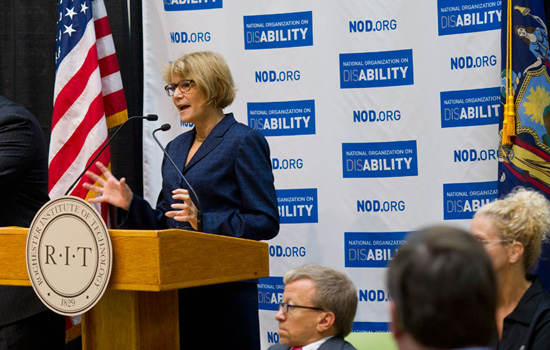National Organization on Disability lauds RIT
NOD kicks off National Disability Employment Awareness Month at RIT Career Fair
A. Sue Weisler
Carol Glazer, president of the National Organization on Disability, joined RIT and national leaders in challenging other universities to bridge the employment gap for students with disabilities. RIT has been credited by the National Organization on Disability as a good example of a university that successfully helps its students find jobs upon graduation.
Rochester Institute of Technology has been credited by the National Organization on Disability as a good example of a university that successfully helps its students find jobs upon graduation.
At a news conference at RIT to kick off National Disability Employment Awareness Month, NOD President Carol Glazer said colleges across the country must do better to provide a pipeline of graduates with disabilities.
“The message we hear repeatedly from corporate America is that while colleges and universities are doing many things well, most fall short in building a pipeline of talent with disabilities,” Glazer said. “Their inability to hire new graduates is not due to a lack of qualified candidates, but rather a lack of access.”
Statistically, students with disabilities take twice as long to find a job after graduation. New federal regulations require federal agencies and companies who contract with them have a target of 7 percent of employees with a disability on their workforce.
“RIT is proud to be recognized as a national leader in helping to place our students with disabilities into the workforce,” said RIT President Bill Destler.
A white paper, “Bridging the Employment Gap for Students with Disabilities,” published by NOD, states there are 1.4 million college students with disabilities, and 60 percent of disabled college graduates are not working. The report offered recommendations for colleges, including better coordination and communication between school career services and disability offices.
The National Technical Institute for the Deaf, one of nine colleges of RIT, has more than 1,200 deaf and hard-of-hearing students, coming from all 50 states and beyond. NTID was created by Congress nearly 50 years ago to provide technical postsecondary education to deaf and hard-of-hearing students. RIT’s long experience with co-operative education—enabling students to get real-world experience in the workplace prior to graduation—was one reason NTID came to Rochester.
NTID’s Center on Employment staff also provides workshops nationally for potential employers to teach them what it is like to work with a deaf or hard-of-hearing individual and what few accommodations may actually be needed.
“With more than 7,700 graduates across the country and beyond, RIT/NTID has been the leader in providing career-focuses postsecondary education for deaf and hard-of-hearing students for more than 45 years,” said NTID President Gerry Buckley. “We work with employers to provide co-op opportunities for our students while in school and careers upon graduation. Despite a rough economy in recent years, 90 to 94 percent of our deaf and hard-of-hearing graduates seeking employment historically have found a job within a year of graduation.”
NTID employs more than 130 sign language interpreters, more than 50 classroom captionists and hundreds of notetakers who provide access to deaf and hard-of-hearing students throughout the RIT campus.
Officials from the National Association of Colleges and Employers (NACE), Career Opportunities for Students with Disabilities (COSD) and General Electric Aviation—a company known for hiring employees with disabilities—also participated in the press conference.




